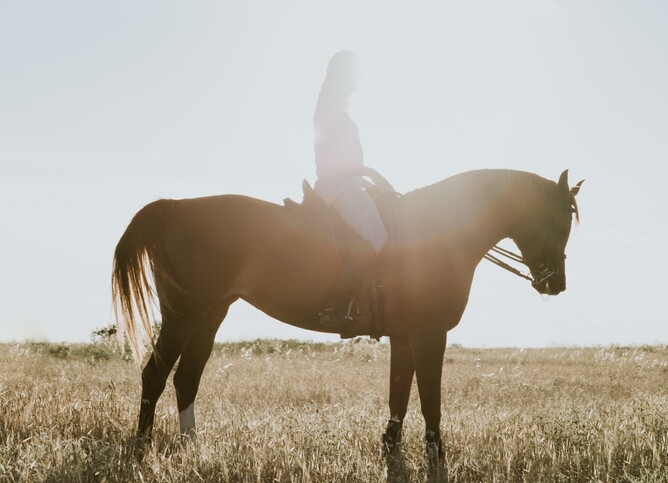If you haven't worked with a saddle fitter before, you may think that we just focus on the saddle, but this isn't the case (life would be easier if it was).
Previously we have talked about girthing and panel types to fit horse's conformation, but let's talk about the topline.
Why?
Because this is what we sit the saddle on. It’s the part of the horse that fluctuates and contributes to most of the fitting changes we see. It’s what we record when we template and body score, and what we are also feeling for ‘health’ when we palpate for any tension under the saddle area.
So what is the topline?
It’s simply how we refer to the muscles that run over the top of the horse's body from neck, wither, spine, and croup.
What is topline health?
This is a term I use when I am looking at the horse's body condition score, and the strength of muscle we are seeing along the topline. For example, if you have a fit eventer, your horse might be lighter in condition (around a 5) so ribs are just visible, but the horse has strong back & neck muscles, and they are deep to feel on palpation over the top of the spine to the ribshelf. It is important to be aware that fat/ barrel shaped horses can have weak toplines too.
What causes poor health?
If your horse is underweight we can usually feel thin muscle over the topline, and we can feel the ribshelf easily, then the muscle is atrophied and not in good health. The same can happen in horses that have had an injury and are box rested, or don’t do any strengthening exercises in their ridden life (happy hackers), or aren’t working in a biomechanically correct outline, have pain issues (ulcers, kissing spine, arthritic changes), are older and don’t build muscle as well, have postural or health issues like cushings or PSSM.
How is the topline improved?
By a combination of factors:
Nutrition- if your horse is struggling with weight, consult a nutritionist and make sure your horse's protein/ fat/fiber ratio is enough to help build muscle.
Exercise- your horse needs to be doing exercises that encourage the hind end to be engaged and pushing through to allow the back and front to lift. UNFIT or POOR TOPLINE horses need to come in carefully to avoid muscle fatigue and compensatory body issues. There are also a ton of groundwork exercises that can be done to help build muscle if your horse is rehabbing or needs more muscle built before riding should be started. If building a topline is out of your depth, work with a coach who can help you.
Body comfort- like us, horses' bodies get tweaked/ strained (we have all seen our horses acting like babies out in the field), if your horse is tight through its body it will often have a compensatory movement which incorrectly builds topline. Regular bodywork is important to make sure your horse is kept comfortable and free. It is also a useful tool to make sure your horse suffering the same issues that may need a further work up/ investigation from a Vet. Regular dentistry and farriery is part of making sure the horse can avoid pain
Gear - This should fit to keep your horse comfortable through it's whole body. Bridles, bits, breastplates, saddles, girths, saddle blankets and half pads should be fitted to your horse, or chosen to suit your horses specific needs. Be aware that lunging devices, side/ draw reins etc aren’t that good at getting your horse to build topline. Make sure if you are using gear you understand what you are trying to achieve, how your gear works, and what to look for if your horse is going correctly in it.
Topline is what we sit the saddle on.
With younger horses we see some change with skeletal growth (mostly due to the muscle strength needing to develop as the horse moves in a slightly different way), and older horses have loss as the muscle struggles to maintain it’s strength. It is the amount of muscle depth/ strength, coupled with posture that influences the width of gullet, the depth of the panel and type of panel best suited for the particular horse.
How do you fit a horse that is going to change shape?
We fit THE HORSE IN FRONT OF US. I appreciate this might not be "the" horse you want it to be at the time of the fitting, and we can make SMALL allowances. But can you imagine if I was selling jeans, you came in as a size 16 and told me that you wanted me to fit you into a size 12 because that's what you usually wear... the list of problems would be large.
If the horse is fat, sometimes we find that the horse templates wider than they actually are because of “squish” and we can get a bit of weight off and support changes with flock before needing to change the gullet. Other times the horse will need to diet and exercise before it can fit back into it’s saddle, or we may be able to change the gullet if they are interchangeable. Thin horses can be fitted with an appropriate half pad or shim pad to help make up for topline, but may also need some better body condition on them before they should be ridden. But if your horse is going to make a change, then it's ideal to get the fitter back when that change has happened so we can once again FIT THE HORSE IN FRONT OF US.
It is very important to understand that a thin horse who is lacking muscle will be lacking protection along it’s back and ribs to carry a rider. Half pads are not enough. Horses must have a reasonable amount of muscle strength if riding is to be of a benefit. Fat horses may look better but they are prone to muscle fatigue too, especially when locked up to diet as they miss out on natural paddock fitness.





